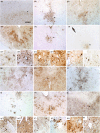Unusual combinations of neurodegenerative pathologies with chronic traumatic encephalopathy (CTE) complicates clinical prediction of CTE
- PMID: 38404144
- PMCID: PMC11235773
- DOI: 10.1111/ene.16259
Unusual combinations of neurodegenerative pathologies with chronic traumatic encephalopathy (CTE) complicates clinical prediction of CTE
Abstract
Background and purpose: Chronic traumatic encephalopathy (CTE) has gained widespread attention due to its association with multiple concussions and contact sports. However, CTE remains a postmortem diagnosis, and the link between clinical symptoms and CTE pathology is poorly understood. This study aimed to investigate the presence of copathologies and their impact on symptoms in former contact sports athletes.
Methods: This was a retrospective case series design of 12 consecutive cases of former contact sports athletes referred for autopsy. Analyses are descriptive and include clinical history as well as the pathological findings of the autopsied brains.
Results: All participants had a history of multiple concussions, and all but one had documented progressive cognitive, psychiatric, and/or motor symptoms. The results showed that 11 of the 12 participants had evidence of CTE in the brain, but also other copathologies, including different combinations of tauopathies, and other rare entities.
Conclusions: The heterogeneity of symptoms after repetitive head injuries and the diverse pathological combinations accompanying CTE complicate the prediction of CTE in clinical practice. It is prudent to consider the possibility of multiple copathologies when clinically assessing patients with repetitive head injuries, especially as they age, and attributing neurological or cognitive symptoms solely to presumptive CTE in elderly patients should be discouraged.
Keywords: CTE; chronic traumatic encephalopathy; concussion; mixed pathology; tau.
© 2024 The Authors. European Journal of Neurology published by John Wiley & Sons Ltd on behalf of European Academy of Neurology.
Conflict of interest statement
None of the authors has any conflict of interest to disclose.
Figures



References
-
- Focus on Traumatic Brain Injury Research. https://www.ninds.nih.gov/current‐research/focus‐disorders/focus‐traumat...
-
- Fischer P, Jungwirth S, Krampla W, et al. Vienna Transdanube Aging “VITA”: Study Design, Recruitment Strategies and Level of Participation. Springer; 2002. - PubMed
Publication types
MeSH terms
Grants and funding
LinkOut - more resources
Full Text Sources

